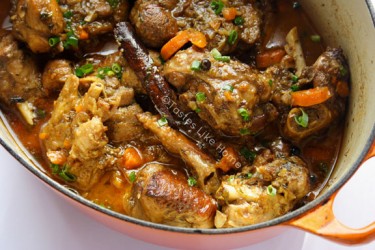Hi Everyone, Developing flavour when cooking is about technique and time. Technique meaning the application or method of cooking used to coax the flavours from ingredients. Time is two-fold:- it is about duration of cooking required for the ingredients to yield their flavours and the time necessary for the dish to rest so that the flavours can meld and provide depth.
One can give several people the same list of ingredients and ask them to make a specific dish, and I bet you that while there will generally be similarities, each dish would taste different based on each cook’s interpretation of the dish and application to the ingredients. Even if you do give directions and instructions in a recipe, the end product always boils down to that cook’s personal treatment of the ingredients.
This week I’m sharing with you a few notes on making certain things. What I’d like you to do (that is, if you don’t already do these things) is to try them and ascertain if you can taste the difference.
Swank/Fruit Drinks
Let’s start with something simple and an all-time favourite – swank/limeade. When you mix the drink with your freshly squeezed lime juice, along with tap water, brown sugar, essence and a splash or two of Angostura Bitters, leave it to chill in the refrigerator for at least 3 hours before drinking it. When you drink it you should notice how smooth it is, there is tartness from the lime but it would have evened out and not be edgy. The “rawness” of the sugar has disappeared and the essence and bitters have melded. The drink tastes like swank yes, but different, something a little more sophisticated. The “resting” of the drink for 3 hours or more acts as the ripening period. This same principle holds through for making many fruit drinks. Make the drinks just as you normally would and then leave them to chill overnight if you can, and immediately upon drinking you will taste the difference.
To test it – make your drink and have some right away, then put it to chill overnight or for several hours and then drink some. You will wonder if you are drinking the same thing.

Rice & Peas
This is an everyday staple that can go from dry and boring to moist and flavourful.
The basic ingredients are rice, rehydrated or fresh peas/beans, oil, onions, thyme, salt, pepper and some type of cooking liquid and if you like, let’s add a piece of salt meat for flavour and seasoning.
Now, to make this dish of rice and peas, you can put all the ingredients in the pot at the same time, bring to boil and then cover and simmer until everything is cooked. It will taste okay when cooked. However, since this is about developing flavour, here is how to take these same ingredients and vary the way in which they are cooked in order to add more flavour to the dish.

Cynthia Nelson)
Heat the oil until hot and then add the onions, thyme and salt meat if using and cook on medium to low heat until the onions are softened and translucent, the oil is now flavoured with the onions, thyme and salt meat.
Add the peas/beans and cook it for a few minutes with the onions, thyme and salt meat. Season it lightly. Now add the washed and drained rice and mix it all up together, season lightly and let it all cook together for a few minutes. Add the cooking liquid you are using – water, coconut milk or stock – bring to a boil for a few minutes, reduce the heat to low/simmer and cook until all the liquid has evaporated and the rice and peas/beans are cooked through. Let the dish rest for 10 – 15 minutes before serving.
I would imagine that just from reading how different the application was to cooking this dish that you would immediately get that it will taste better than the version of just throwing everything into the pot at one time without coaxing the flavours from the aromatics in the dish.
Tip: the cooking liquid – water, coconut milk, stock – used to cook the dish will impact on the final flavour profile as well as the type of peas/beans being used to make the dish. The cooking time will vary for each type of peas/beans before adding the rice.
Marinating
There is a reason why recipes give times for marinating – the times range from 1 hour to 24 hours depending on what is being made. The whole idea for the long curing period is for the aromatics – spices, herbs, seasoning liquids – to penetrate the ingredients with their flavour so that when cooked, the flavour is on the inside as well as the outside.
Here’s a test – season cut-up chicken and bake it immediately. It will most certainly taste delicious. But give that same chicken several hours or overnight to marinate and you will taste the depth of flavour when you cook it later.
Sauces, Condiments,Seasonings
When we make things like pepper sauce, achar, chutneys, dips, spreads and marinades we automatically do not use them right away. We give these concoctions time to settle, time to cure, time to ripen, time to mature, time for the flavours to develop. If we consume or use many of them immediately after we make them, the taste is generally okay, and somewhat ‘raw’, however, when used after a period of maturity, the flavour is pronounced, mellow, smooth or heightened depending on what it is.
Fruit preserves such as jams, jellies and marmalade fall into this same category as well – that is leaving to ripen or age over a period of time so that the ingredients are fused to create something that is lip-smacking, finger-licking good.
Curries, Stews & Soups
Think about these dishes. Curries are all about the deft use of spices and aromatics such as garlic and herbs cooked with meat, poultry, seafood or vegetables. The gravy or broth is full of flavour. While curries are excellent when made and eaten immediately when it’s done cooking, have that same curry for dinner or just a couple of hours later and you are bound to notice how much better the curry tastes. Heat it up the next day and it gets even better. The same is true for stews and soups.
Ever notice how next-day Cook-up Rice or Pelau is better than they day when it was made fresh? So good!
Pies & Salads
A potato salad needs time to set up. Not only does it need to have that right degree of coolness, but it needs time for the dressing to become uniform as it sits coating the potatoes.
Egg salad, fig salad and chicken salad all benefit from a period of resting so that the flavours can meld. Eaten warm these salads tastes one way, eaten well chilled and after resting for several hours, the varying notes of flavour dance across the tongue.
Pies such a macaroni pie and lasagne need time to set as well. To get that sharp cheesiness and the full-body mouth feel of the pasta, the macaroni pie should rest for at least an hour before eating once removed from the oven. You don’t have to worry about it getting cold, because the pie is compact, it stays hot for a long time. This setting period is always ideal as it makes for uniform cutting of the pie.
Batters & Bread
Batters for things like fish cakes, phulourie, shrimp cakes, and certain types of fritters need time to rest, not only to develop flavour but also to enable them to cook up properly.
There is bread and then there is bread. The most flavourful of breads are those with a long, slow fermentation where the yeast and flour have been given much time to fuse and ferment. These types of breads are usually referred to as artisan breads given the method of preparation. The taste and texture is far superior.
And finally, the big kahuna – Christmas cake, Black cake, Great cake. There is a reason why people get all fussy about making this cake. The alcohol-soaked fruits are the star and must be of a certain age of maturity for the cake to have that highly sought-after flavour and texture when cooked.
I won’t blame you for thinking that in order for flavour to be developed, the process of cooking has to be long or that consumption has to be delayed. The development of flavour varies depending on what it is that you are making. There are some little things that you can do in everyday cooking that give your food the flavour boost it needs, and no I am suggesting that you drop bouillon cubes here and there.
For example, cooking your pasta and ground provisions in boiling salted water to season the pasta and give taste to the ground provisions. When you cook your every day rice, add a little salt and taste how more inviting the rice is. If you are poaching chicken or seafood, add spices, herbs and salt to the poaching liquid to season and flavour. Instead of oven roasting, try fire-roasting and notice how the flavour profile of your dish is different. Mix up your cooking liquids – water, coconut milk, stock. Vary your cooking methods.
Cynthia
Cynthia@tasteslikehome.org
www.tasteslikehome.org





